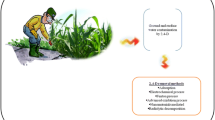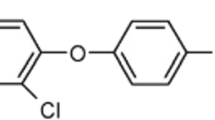Abstract
Phenoxyacetic and benzoic acid herbicides are widely used agricultural, commercial, and domestic pesticides. As a result of high water solubility, mobility, and persistence, 2,4-dichlorophenoxyacetic acid (2,4-D), methylchlorophenoxypropionic acid (mecoprop), and 3,6-dichloro-2-methoxybenzoic acid (dicamba) have been detected in surface and waste waters across Canada. As current municipal wastewater treatment plants do not specifically address chronic, trace levels of contaminants like pesticides, an urgent need exists for an efficient, environmentally friendly means of breaking down these toxic herbicides. A commercially available herbicide mix, WeedEx, containing 2,4-D, mecoprop, and dicamba, was subjected to treatment using membrane bioreactor (MBR) technology. The three herbicides, in simulated wastewater with a chemical oxygen demand of 745 mg/L, were introduced to the MBR at concentrations ranging from 300 μg/L to 3.5 mg/L. Herbicides and biodegradation products were extracted from MBR effluent using solid-phase extraction followed by detection using high-performance liquid chromatography coupled with mass spectrometry. 2,4-D was reduced by more than 99.0 % within 12 days. Mecoprop and dicamba were more persistent and reduced by 69.0 and 75.4 %, respectively, after 112 days of treatment. Half-lives of 2,4-D, mecoprop and dicamba during the treatment were determined to be 1.9, 10.5, and 28.3 days, respectively. Important water quality parameters of the effluent such as dissolved oxygen, pH, ammonia, chemical oxygen demand, etc. were measured daily. MBR was demonstrated to be an environmentally friendly, compact, and efficient method for the treatment of toxic phenoxyacetic and benzoic acid herbicides.







Similar content being viewed by others
References
Aksu Z, Kabasakal E (2004) Batch adsorption of 2,4-dichlorophenoxy-acetic acid (2,4-D) from aqueous solution by granular activated carbon. Sep Purif Technol 35(3):223–240. doi:10.1016/s1383-5866(03)00144-8
Amy PS, Schulke JW, Frazier LM, Seidler RJ (1985) Characterization of aquatic bacteria and cloning of genes specifying partial degradation of 2,4-dichlorophenoxyacetic acid. Appl Environ Microbiol 49(5):1237–1245
Beltran FJ, Gonzalez M, Rivas J, Marin M (1994) Oxidation of mecoprop in water with ozone and ozone combined with hydrogen peroxide. Ind Eng Chem Res 33(1):125–136. doi:10.1021/ie00025a017
Bernhard M, Müller J, Knepper TP (2006) Biodegradation of persistent polar pollutants in wastewater: comparison of an optimised lab-scale membrane bioreactor and activated sludge treatment. Water Res 40(18):3419–3428. doi:10.1016/j.watres.2006.07.011
Brillas E, Calpe JC, Casado J (2000) Mineralization of 2,4-D by advanced electrochemical oxidation processes. Water Res 34(8):2253–2262. doi:10.1016/s0043-1354(99)00396-6
Brimble S (2005) Pesticide utilization in Canada: a compilation of current sales and use data. Environment Canada, Ottawa
Buenronstro-Zagal, JF, Ramirez-Oliva, A., Caffarel-Mendez, S, Schettino-Bermudez, B, Poggi-Varaldo HM (2000) Treatment of a 2, 4-dichlorophenoxyacetic acid (2, 4-D) contaminated wastewater in a membrane bioreactor. Water Sci Technol 42(5/6)185–192
Buser HR, Müller MD, Theobald N (1998) Occurrence of the pharmaceutical drug clofibric acid and the herbicide mecoprop in various Swiss lakes and in the North Sea. Environ Sci Technol 32(1):188–192
Canadian Council of Ministers of the Environment (2007) Canadian water quality guidelines for the protection of aquatic life. Canadian environmental quality guidelines. Canadian Council of Ministers of the Environment, Winnipeg
Canziani R, Emondi V, Garavaglia M, Malpei F, Pasinetti E, Buttiglieri G (2006) Effect of oxygen concentration on biological nitrification and microbial kinetics in a cross-flow membrane bioreactor (MBR) and moving-bed biofilm reactor (MBBR) treating old landfill leachate. J Membr Sci 286(1–2):202–212. doi:10.1016/j.memsci.2006.09.044
Clara M, Strenn B, Gans O, Martinez E, Kreuzinger N, Kroiss H (2005) Removal of selected pharmaceuticals, fragrances and endocrine disrupting compounds in a membrane bioreactor and conventional wastewater treatment plants. Water Res 39(19):4797–4807. doi:10.1016/j.watres.2005.09.015
CropLife Canada (2011) Cultivating a Vibrant Canada: Annual Report 2010/2011. Ottawa
Defrance L, Jaffrin MY, Gupta B, Paullier P, Geaugey V (2000) Contribution of various constituents of activated sludge to membrane bioreactor fouling. Bioresour Technol 73(2):105–112. doi:10.1016/s0960-8524(99)00163-7
Degenhardt D, Cessna AJ, Raina R, Farenhorst A, Pennock DJ (2011) Dissipation of six acid herbicides in water and sediment of two Canadian prairie wetlands. Environ Toxicol Chem 30(9):1982–1989. doi:10.1002/etc.598
Drzewicz P, Trojanowicz M, Zona R, Solar S, Gehringer P (2004) Decomposition of 2,4-dichlorophenoxyacetic acid by ozonation, ionizing radiation as well as ozonation combined with ionizing radiation. Radiat Phys Chem 69(4):281–287. doi:10.1016/s0969-806x(03)00471-7
Eaton AD, Clesceri LS, Rice EW, Greenberg AE (2005) Standard methods for the examination of water and wastewater, 21st edn. American Public Health Association, Washington, D. C
Environment Canada (2011) Presence and levels of priority pesticides in selected Canadian aquatic ecosystems. Environment Canada, Ottawa
Environment Canada (1976) Guidelines for effluent quality and wastewater treatment at federal establishments. Federal Activities Environmental Branch, Environmental Conservation Directorate, Ottawa
Evangelista S, Cooper DG, Yargeau V (2010) The effect of structure and a secondary carbon source on the microbial degradation of chlorophenoxy acids. Chemosphere 79(11):1084–1088. doi:10.1016/j.chemosphere.2010.03.018
Federal-Provincial Subcommittee on Drinking Water (1996) Guidelines for Canadian drinking water quality. Health Canada, Ottawa
Flox C, Garrido JA, Rodríguez RM, Cabot P-L, Centellas F, Arias C, Brillas E (2007) Mineralization of herbicide mecoprop by photoelectro-Fenton with UVA and solar light. Catal Today 129(1–2):29–36. doi:10.1016/j.cattod.2007.06.049
Ghoshdastidar AJ, Saunders JE, Brown KH, Tong AZ (2012) Membrane bioreactor treatment of commonly used organophosphate pesticides. J Environ Sci Health B 47(7):742–750
Glozier N, Struger J, Cessna A, Gledhill M, Rondeau M, Ernst W, Sekela M, Cagampan S, Sverko E, Murphy C, Murray J, Donald D (2012) Occurrence of glyphosate and acidic herbicides in select urban rivers and streams in Canada, 2007. Environ Sci Pollut Res 19(3):821–834. doi:10.1007/s11356-011-0600-7
González S, Petrovic M, Barceló D (2007) Removal of a broad range of surfactants from municipal wastewater—comparison between membrane bioreactor and conventional activated sludge treatment. Chemosphere 67(2):335–343. doi:10.1016/j.chemosphere.2006.09.056
Hamilton D, Crossley S (2004) Introduction. In: Hamilton D, Crossley S (eds) Pesticide residues in Food and drinking water: Human exposure and risks, vol 2. Agrochemicals and Plant Protection. Wiley. doi:10.1002/0470091614
Harrison I, Williams GM, Carlick CA (2003) Enantioselective biodegradation of mecoprop in aerobic and anaerobic microcosms. Chemosphere 53(5):539–549. doi:10.1016/s0045-6535(03)00456-9
Haugland RA, Schlemm DJ, Lyons RP, Sferra PR, Chakrabarty AM (1990) Degradation of the chlorinated phenoxyacetate herbicides 2,4-dichlorophenoxyacetic acid and 2,4,5-trichlorophenoxyacetic acid by pure and mixed bacterial cultures. Appl Environ Microbiol 56(5):1357–1362
Heron G, Christensen TH (1992) Degradation of the herbicide mecoprop in an aerobic aquifer determined by laboratory batch studies. Chemosphere 24(5):547–557. doi:10.1016/0045-6535(92)90211-9
Kim K-P, Ahmed Z, Ahn K-H, Paeng K-J (2009) Biodegradation of two model estrogenic compounds in a preanoxic/anaerobic nutrient removing membrane bioreactor. Desalination 243(1–3):265–272. doi:10.1016/j.desal.2007.12.057
Kose B, Ozgun H, Ersahin ME, Dizge N, Koseoglu-Imer DY, Atay B, Kaya R, Altınbas M, Sayılı S, Hoshan P, Atay D, Eren E, Kinaci C, Koyuncu I (2012) Performance evaluation of a submerged membrane bioreactor for the treatment of brackish oil and natural gas field produced water. Desalination 285:295–300. doi:10.1016/j.desal.2011.10.016
Kreuger J, Brink N (1988) Losses of pesticides from arable land. Växtskyddsrapporter Jordbruk 49:50–61
Kurt-Karakus PB, Bidleman TF, Muir DCG, Cagampan SJ, Struger J, Sverko E, Small JM, Jantunen LM (2008) Chiral current-use herbicides in Ontario streams. Environ Sci Technol 42(22):8452–8458. doi:10.1021/es8011854
Li X-y, Chu HP (2003) Membrane bioreactor for the drinking water treatment of polluted surface water supplies. Water Res 37(19):4781–4791. doi:10.1016/s0043-1354(03)00424-x
Lin H, Chen J, Wang F, Ding L, Hong H (2011) Feasibility evaluation of submerged anaerobic membrane bioreactor for municipal secondary wastewater treatment. Desalination 280(1–3):120–126. doi:10.1016/j.desal.2011.06.058
Liu Q, Wang XC, Liu Y, Yuan H, Du Y (2010) Performance of a hybrid membrane bioreactor in municipal wastewater treatment. Desalination 258(1–3):143–147. doi:10.1016/j.desal.2010.03.024
Lu M-C, Chen J-N (1997) Pretreatment of pesticide wastewater by photocatalytic oxidation. Water Sci Technol 36(2–3):117–122. doi:10.1016/s0273-1223(97)00377-6
Magga Z, Tzovolou DN, Theodoropoulou MA, Dalkarani T, Pikios K, Tsakiroglou CD (2008) Soil column experiments used as a means to assess transport, sorption, and biodegradation of pesticides in groundwater. J Environ Sci Health B 43(8):732–741. doi:10.1080/03601230802388868
Mangat SS, Elefsiniotis P (1999) Biodegradation of the herbicide 2,4-dichlorophenoxyacetic acid (2,4-D) in sequencing batch reactors. Water Res 33(3):861–867. doi:10.1016/s0043-1354(98)00259-0
Marrot B, Barrios-Martinez A, Moulin P, Roche N (2004) Industrial wastewater treatment in a membrane bioreactor: a review. Environ Prog 23(1):59–68. doi:10.1002/ep.10001
Melin T, Jefferson B, Bixio D, Thoeye C, De Wilde W, De Koning J, van der Graaf J, Wintgens T (2006) Membrane bioreactor technology for wastewater treatment and reuse. Desalination 187(1–3):271–282. doi:10.1016/j.desal.2005.04.086
Nitschke L, Wilk A, Schüssler W, Metzner G, Lind G (1999) Biodegradation in laboratory activated sludge plants and aquatic toxicity of herbicides. Chemosphere 39(13):2313–2323. doi:10.1016/s0045-6535(99)00140-x
Norris LA, Montgomery ML (1975) Dicamba residues in streams after forest spraying. Bull Environ Contam Toxicol 13(1):1–8. doi:10.1007/bf01684856
Paterlini WC, Nogueira RFP (2005) Multivariate analysis of photo-Fenton degradation of the herbicides tebuthiuron, diuron and 2,4-D. Chemosphere 58(8):1107–1116. doi:10.1016/j.chemosphere.2004.09.068
Petrovic M, de Alda MJL, Diaz-Cruz S, Postigo C, Radjenovic J, Gros M, Barcelo D (2009) Fate and removal of pharmaceuticals and illicit drugs in conventional and membrane bioreactor wastewater treatment plants and by riverbank filtration. Phil Trans R Soc A Math Phys Eng Sci 367(1904):3979–4003. doi:10.1098/rsta.2009.0105
Phillips PJ, Bode RW (2004) Pesticides in surface water runoff in south-eastern New York State, USA: seasonal and stormflow effects on concentrations. Pest Manag Sci 60(6):531–543. doi:10.1002/ps.879
Prado J, Arantegui J, Chamarro E, Esplugas S (1994) Degradation of 2, 4-D by ozone and light. Ozone-Sci Eng 16(3):235–245
Radjenovic J, Petrovic M, Barceló D (2007) Analysis of pharmaceuticals in wastewater and removal using a membrane bioreactor. Anal Bioanal Chem 387(4):1365–1377. doi:10.1007/s00216-006-0883-6
Rawn DFK, Halldorson THJ, Woychuk RN, Muir DCG (1999) Pesticides in the Red River and its tributaries in Southern Manitoba: 1993–95. Water Qual Res J Can 34(2):183–219
Shariati FP, Mehrnia MR, Salmasi BM, Heran M, Wisniewski C, Sarrafzadeh MH (2010) Membrane bioreactor for treatment of pharmaceutical wastewater containing acetaminophen. Desalination 250(2):798–800. doi:10.1016/j.desal.2008.11.044
Somasundaram L, Coats JR, Racke KD, Stahr HM (1990) Application of the microtox system to assess the toxicity of pesticides and their hydrolysis metabolites. Bull Environ Contam Toxicol 44(2):254–259. doi:10.1007/bf01700144
Sun Y, Pignatello JJ (1995) Evidence for a surface dual hole-radical mechanism in the titanium dioxide photocatalytic oxidation of 2,4-D. Environ Sci Technol 29(8):2065–2072. doi:10.1021/es00008a028
Toräng L, Nyholm N, Albrechtsen H-J (2003) Shifts in biodegradation kinetics of the herbicides MCPP and 2,4-D at low concentrations in aerobic aquifer materials. Environ Sci Technol 37(14):3095–3103. doi:10.1021/es026307a
University of Hertfordshire (2012) Pesticide Properties Database (PPDB). Agriculture & Environment Research Unit, University of Hertfordshire. http://sitem.herts.ac.uk/aeru/footprint/en/index.htm. Accessed March 26, 2012
Visvanathan C, Aim RB, Parameshwaran K (2000) Membrane separation bioreactors for wastewater treatment. Crit Rev Environ Sci Technol 30:1–48
Wang Q, Lemley AT (2001) Kinetic model and optimization of 2,4-D degradation by anodic Fenton treatment. Environ Sci Technol 35(22):4509–4514. doi:10.1021/es0109693
Wells MJM, Yu LZ (2000) Solid-phase extraction of acidic herbicides. J Chromatogr A 885(1–2):237–250. doi:10.1016/s0021-9673(00)00206-5
Woudneh MB, Ou Z, Sekela M, Tuominen T, Gledhill M (2009) Pesticide multiresidues in waters of the lower Fraser valley, British Columbia, Canada. Part I. Surface water. J Environ Qual 38(3):940–947
Yang J, Wang XZ, Hage DS, Herman PL, Weeks DP (1994) Analysis of dicamba degradation by pseudomonas maltophilia using high-performance capillary electrophoresis. Anal Biochem 219(1):37–42. doi:10.1006/abio.1994.1228
Zipper C, Bolliger C, Fleischmann T, Suter MJF, Angst W, Müller MD, Kohler H-PE (1999) Fate of the herbicides mecoprop, dichlorprop, and 2,4-D in aerobic and anaerobic sewage sludge as determined by laboratory batch studies and enantiomer-specific analysis. Biodegradation 10(4):271–278. doi:10.1023/a:1008396022622
Acknowledgments
The authors would like to acknowledge the financial support from Acadia University, the Natural Sciences and Engineering Research Council of Canada (NSERC), and the Nova Scotia Health Research Foundation (NSHRF). In addition, the authors would like to thank Dr. Yiming Zeng (Superstring MBR Technology, Corp.), Dr. Martin Tango (School of Engineering, Acadia University), and Jim Frazee (E&Q Consulting Limited) for their technical assistance and helpful discussion in this project.
Author information
Authors and Affiliations
Corresponding author
Additional information
Responsible editor: Philippe Garrigues
Rights and permissions
About this article
Cite this article
Ghoshdastidar, A.J., Tong, A.Z. Treatment of 2,4-D, mecoprop, and dicamba using membrane bioreactor technology. Environ Sci Pollut Res 20, 5188–5197 (2013). https://doi.org/10.1007/s11356-013-1498-z
Received:
Accepted:
Published:
Issue Date:
DOI: https://doi.org/10.1007/s11356-013-1498-z




